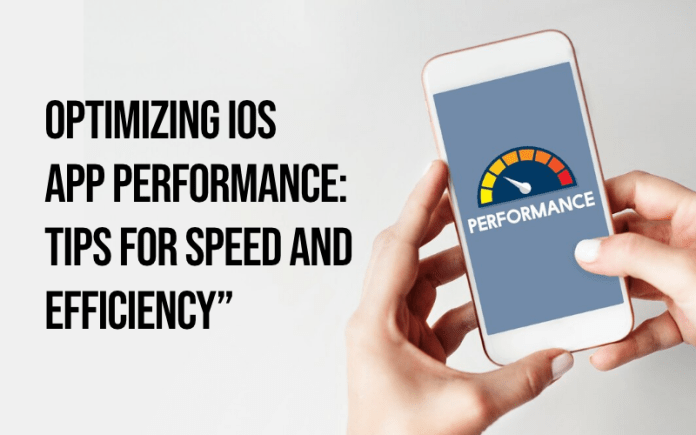In the ever-evolving world of mobile app development, developing an iOS app that functions smoothly as well as delivers a pleasant user experience is crucial. This is when app store optimization plays a significant role in meeting this goal. iOS app optimization not only enhances the performance but also ensures that it runs smoothly on all Apple devices.
As a result, the demand for iOS development services is increasing because of the benefits it offers, like enhanced security, better app revenue, high-quality standards, and more.
In this blog, we will learn some prominent strategies and best practices to help you optimize your iOS app.
Efficient Code and Resource Management
When optimizing your iOS app, it is important to focus on code efficiency and resource management, as unused resources or enlarged codes reduce the app’s performance.
You can consider the following tips:
- Minimize Code Bloat: Remove unnecessary code, comments, and debug statements. Keep your codebase clean and well-organized.
- Image Optimization: Compress and use appropriate image formats (e.g., WebP or JPEG) to reduce the size of image assets.
- Memory Management: Use ARC (Automatic Reference Counting) to manage memory efficiently. Avoid memory leaks by understanding the memory lifecycle.
UI and UX Enhancements
Another important factor to consider during the iOS app optimization is focusing on delivering a smooth & intuitive experience (UI) for the utmost customer satisfaction. By considering the following points, you can optimize your iOS app’s UI and boost the user experience.
Let’s see how:
- UI Responsiveness: You must make sure that your iOS app’s UI responds instantly to user interactions. Utilize background threads for heavy tasks to avoid freezing the UI.
- Adaptive Layouts: You can integrate responsive designs that adapt to various screen sizes and orientations, including different iPhone and iPad models.
- Animations: Use lightweight & engaging animations and transitions to create a visually appealing interface. Avoid excessive animations that can slow down the app.
Network Efficiency
Mobile applications are often dependent on network requests for data retrieval because effective network management majorly impacts app performance. The following are key points to consider to maintain the network efficiency.
- Caching: Implement caching mechanisms to keep the storage of frequently used data locally and reduce the need for repeated network requests.
- Batch Requests: Minimize the number of network requests by batching them when possible, reducing latency and conserving battery life.
- Background Fetch: Use background fetch and push notifications for timely updates instead of polling the server continuously.
Battery Optimization
The excessive consumption of power results in a poor user experience that is why, it is important to optimize your iOS application for energy efficiency. With the help of the following points, you can ensure your iOS app’s energy consumption.
- Background Processing: You can reduce the amount of background processing along with the background location updates when not in use.
- Location Services: The second way to optimize your iOS app’s battery is by using the location only when required. You can even use low-battery mode when high accuracy is not required.
- Real-Time Notifications: The next key point to consider for your iOS app’s battery optimization is utilizing silent push notifications. It updates the app content in the background.
App-Size Reduction
Developing a smaller-sized iOS application is advantageous as it not only grabs the targeted audience’s attention but also gets easily downloaded. The app size reduction significantly impacts the conversion rate. You can consider the following points to keep your app’s size smaller.
Let’s see how:
- App Thinning: You can leverage Apple’s technology, called App Thinning, which can help you deliver optimized app bundles for specific devices.
- Asset Slicing: Leverage the asset-slicing feature to minimize the overall size of your iOS app by delivering the required assets for your user’s device.
- Remove Unused Code: Lastly, make sure that the app you are developing has code that is relevant to your targeted architecture of the device.
Performance Testing
If you want to make sure that your iOS app is running smoothly with fewer risks of any bugs, conduct performance tests. Regular testing of your app on various devices & versions will help you find any issues or check whether your app is compatible with several devices or not. Utilize profiling tools, like instruments to analyze CPU, memory, and network usage.
You can also monitor different metrics before starting the complete iOS app development process. Such as:
- App launch time
- App stability
- Battery consumption
- Logic execution speed
- Memory usage
- Network performance
- UI response times
Concluding Words
A dedication to delivering an excellent user experience and meticulous attention to detail are prerequisites for the continuous process of optimizing your iOS app. Your iOS app can run as smoothly as possible on a variety of Apple devices if you concentrate on effective code and resource management, UI/UX improvements, network efficiency, battery optimization, app size reduction, and performance testing. Keep in mind that the speed, responsiveness, and general performance of your app can have a significant impact on user satisfaction and retention, so optimization is an essential component of your app development strategy.
